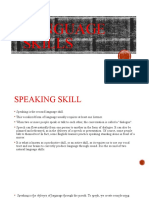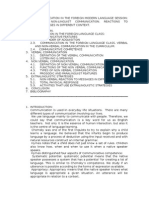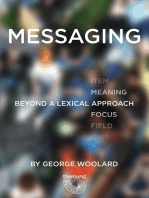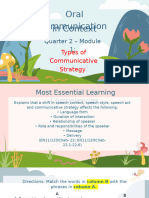Методика анг
Методика анг
Uploaded by
akbotarymzhanCopyright:
Available Formats
Методика анг
Методика анг
Uploaded by
akbotarymzhanCopyright
Available Formats
Share this document
Did you find this document useful?
Is this content inappropriate?
Copyright:
Available Formats
Методика анг
Методика анг
Uploaded by
akbotarymzhanCopyright:
Available Formats
Date: 20/02/2024
Group: SH 21
Theme: Teaching Speaking Skills
Aim: to introduce students with the main ways of Teaching Speaking Skills.
Literature:
Council of Europe, Communication in the modern language classroom, by Joe Sheils, 1993
Jim Scrivener, Learning Teaching, Macmillan Books for Teachers, 2007, p. 155-163
https://studfile.net/preview/3495592/page:4/
Procedure
Task 1 Study the lecture and write down it in your copy – book in short form.
Task 2. Do the test.
Lecture.
Ways of Teaching Speaking Skills
Communication involves the use of four language skills:
listening and speaking in oral communication
reading and writing in written communication.
The sender of the message uses speaking or writing skills to communicate ideas, the receiver uses
listening or reading skills to interpret the massage. The skills used by the sender are productive and those
used by the receiver are receptive (or interpretive).
The use of each skills demands various components of language substance. Each skill involves the use
of specific vehicles.
Learners usually attain a much higher level of proficiency in the receptive skills than in the productive
skills. Mastering the language skills, like mastering any kind of skill, requires a considerable amount of
practice. Step by step in the teaching-learning development process the learner should become more
proficient.
When we say a person knows the language, we first of all mean he understands the language spoken
and can speak himself. Language came into life as a means of communication. It exists and is alive only
through speech. When we speak about teaching a foreign language, we first of all have in mind teaching it as
a means of communication. Speech is a bilateral process. It includes hearing and speaking. Speaking exists
in two forms: dialogue and monologue.
Developing Oral Communication Skills
Developing oral communication skills attention should be concentrated on the following main
problems:
syllabus requirements
language and speech
physiological and linguistic characteristics of speech
ways of creating situations
prepared, unprepared and inner speech
types of exercises.
Oral communication has 2 types: productive-speaking and receptive-listening.
The syllabus requirements for developing oral communication are as follows:
to listen and understand the language spoken
to carry on a conversation and to speak a foreign language within the topics and linguistic
material the syllabus sets.
Oral language is a means of testing pupils’ comprehension when they read or hear a text.
Properly used oral language ensures pupils’ progress in language learning and, consequently, arouses
their interest in the subject.
Language and Speech
Language refers to the linguistic system. It is a system of forms, which any speaker possesses. It
enables him to produce meaningful sentences.
Speech is the activity of using a language system for communicative purposes in real situation. We
should seek methods of teaching not language so much, as communication through the language.
Mastery of language depends not only on what the language is, but also on what the language is for.
That is for communication language system of forms is taught to help the learners to develop their
philological and logical thinking on the one hand and as a means of developing communication skills, on the
other. Both of them are equally important.
To get a better understanding of what speech is, the teachers should know psychological and linguistic
characteristics of speech.
Psychological Characteristics of Speech
Speech must be motivated.
The speaker should have inner motivation, a desire, a necessity to say sth. to someone. Motive is the
factor, which incites a person’s will to do or say sth. When we speak we want either to say sth to someone or
get information from someone about sth. important. Pupils should have a necessity, desire to express their
thoughts and feelings, to inform the hearer of sth. Interesting, important or to get information. Their speech
should be stimulated (by the teacher).
Speech is always addressed to an interlocutor.
We don’t speak when there is no one to address the speech. Teaching oral language pupils should
address, speak to someone, to their classmates, to the class, to the teacher. They should interact.
During English lesson the pupils very often don’t know where to look while they speak, they look
either at the ceiling or out of the window, because they don’t know whom their speech is addressed to. This
point is closely connected with motivation. When we have an inner necessity to say sth, we should say it to
someone. So the teacher should suggest: “Tell the class… Ask your friend… Tell me…”
Speech is always emotionally coloured for a speaker expresses his/her thoughts, feelings,
attitude what he/she says.
That’s why the pupils should be taught to use emotional means to express their feelings about what they say.
Speech is always situational.
It takes place in a certain situation. There can be no speech out of situation. There can be no speech
out of situation. Situation is the integrity of circumstances in which the human beings are motivated to
develop speech activity. The main components of situations are: the speaker, the stimulus to speech and the
person to whom the speech is addressed.
Linguistic Characteristics of Speech
Oral language as compared to written language is more flexible. It is relatively free and is
characterized by some peculiarities in vocabulary and grammar. We don’t teach pupils colloquial English.
That’s why oral language taught in schools is close to written language standards and especially its
monologic forms.
Linguistic peculiarities of dialogue are as follows:
1. The use of incomplete sentences (ellipses) in response:
e.g. Where do you live? - In Yerevan. How many books do you have? – One.
2. The use of contracted forms: doesn’t. won’t, haven’t, can’t
3. The use of some abbreviations: lab, bike, math’s, fridge, comp, etc.
4. The use of conversational tags. These are the words the speaker uses when he/she wishes to speak
without saying anything: e.g of course, perhaps, surely, etc.
Prepared and Unprepared Speech
Pupils’ speech whether it is a monologue or dialogue may be of 2 kinds: prepared and unprepared.
When the pupils are given enough time to think over the content and form of his speech. it is prepared
speech. He can speak on the subject following the plan made either independently at home or in class under
the teacher’s supervision. His speech will be more or less correct and sufficiently fluent since plenty of
preliminary exercises had been done before.
When the pupil speaks without any previous preparation, his speech is unprepared and he can:
speak on a subject suggested by the teacher
speak on the text read (summarize or give content)
discuss problems touched upon in the text read or heard
help a “foreigner”, e.g. to find the way to some place.
Prepared and unprepared speech must be developed simultaneously from the very beginning. In
junior stage prepared speech takes the lead, while in senior stage unprepared speech should prevail. The aim
of teaching is to develop the learners' unprepared speech.
Principles for Designing Speaking Techniques
1.Techniques should cover the spectrum of learner needs, from
language-based focus on accuracy to message-based focus on
interaction, meaning, and fluency 1.
When you do a jigsaw group technique, play a game, or discuss solutions to the environmental crisis,
make sure that your tasks include techniques designed to help students to perceive and use the building
blocks of language. At the same time, don't bore your students with lifeless, repetitious drills. The drills
must be as meaningful as possible.
2. Techniques should be intrinsically motivating.
Try at all times to appeal to students' ultimate goals and interests, to their need for knowledge, for
achieving competence, autonomy, and for "being all that they can be." Even in those techniques help them
to see how the activity will benefit them.
Many times students don't know why we ask them to do certain activities. So techniques should
encourage the use of authentic language in meaningful contexts.
It is not easy to keep coming up with meaningful interaction. It takes energy and creativity to devise
authentic contexts and meaningful interaction, but with the help of quite a storehouse of teacher resource
material now it can be done. Even drills can be structured to provide a sense of authenticity.
4. Provide appropriate feedback and correction.
In most EFL situations, students are totally dependent on the teacher for useful linguistic feedback. It
is important that you take advantage of your knowledge of English to inject the kinds of corrective feedback
that are appropriate for the moment.
5. Capitalize on the natural link between speaking and listening.
Many interactive techniques that involve speaking will also of course include listening. Don't lose out
on opportunities to integrate these two skills. As you are perhaps focusing on speaking goals, listening goals
may naturally coincide, and the two skills can reinforce each other. Skills in producing language are often
initiated through comprehension.
6. Give students opportunities to initiate oral communication.
A good deal of typical classroom interaction is characterized by teacher initiation of language. We ask
questions, give directions, provide information, and students have been conditioned only to "speak when
spoken to." Part of oral communication competence is the ability to initiate conversations, to nominate
topics, to ask questions, to control conversations, and to change the subject. As you design and use speaking
techniques, ask yourself if you have allowed students to initiate language.
7. Encourage the development of speaking strategies.
The concept of strategic competence is one that language students must be awared of. They simply
have not thought about developing their own personal strategies for accomplishing oral communicative
purposes. Your classroom can be one in which students become aware of, and have a chance to
practice such strategies as:
asking for clarification (What?)
asking someone to repeat something (Huh? Excuse me?)
using fillers (Uh, I mean, Well) in order to gain time to process
using conversation maintenance cues (Uh huh, Right, Yeah, Okay, Hm)
getting someone's attention (Hey, Say, So)
using paraphrases for structures one can't produce
appealing for assistance from the interlocutor (to get a word or phrase, for example)
using mime and nonverbal expressions to convey the meaning.
You might also like
- Chapter I - V PTKDocument32 pagesChapter I - V PTKMuhamad Ongky NRahardiNo ratings yet
- Lecture 11. Teaching SpeakingDocument7 pagesLecture 11. Teaching SpeakingarailymoooNo ratings yet
- Types of PatternDocument25 pagesTypes of Patternmaylene marquezNo ratings yet
- Language SkillsDocument7 pagesLanguage SkillsAlgen Jewel BalbinNo ratings yet
- Methods of Language TeachingDocument27 pagesMethods of Language TeachingRishaliney NadarajahNo ratings yet
- Characteristics of Speech ActivityDocument11 pagesCharacteristics of Speech ActivityАйгера МерейNo ratings yet
- A Descriptive Study On TeachingDocument21 pagesA Descriptive Study On TeachingaitonxNo ratings yet
- Assignment 1 TesolDocument5 pagesAssignment 1 TesolJimmi KhanNo ratings yet
- Trabajo Practico Didactica I Mary and YanniDocument8 pagesTrabajo Practico Didactica I Mary and YanniYanni ArgañarazNo ratings yet
- Lesson 7 Spec 5 - Baby Jean Saguban & Jedon SayconDocument41 pagesLesson 7 Spec 5 - Baby Jean Saguban & Jedon SayconRosie AbrasaldoNo ratings yet
- Chapter2 (Teaching Speaking Using Short Story)Document13 pagesChapter2 (Teaching Speaking Using Short Story)Sayyidah BalqiesNo ratings yet
- Teaching SkillsDocument78 pagesTeaching SkillsMarcis TrautmannNo ratings yet
- Teaching SpeakingDocument15 pagesTeaching SpeakingRodeliza Jean JapsonNo ratings yet
- 55fbb8b0dd37d Productive SkillDocument6 pages55fbb8b0dd37d Productive SkilldewiNo ratings yet
- English Reviewer 1Document31 pagesEnglish Reviewer 1camungaoaldrine23No ratings yet
- Lac NoteDocument13 pagesLac NoteAdu Charles OseiNo ratings yet
- Handbook of Readings.pdf · إصدار ١Document80 pagesHandbook of Readings.pdf · إصدار ١Abou FiredNo ratings yet
- Language SkillsDocument39 pagesLanguage SkillssairaNo ratings yet
- SpeakingDocument9 pagesSpeakingankit.biswas.2024No ratings yet
- Module in Approaches For Language Arts TeachingDocument6 pagesModule in Approaches For Language Arts TeachingrosevicabangayNo ratings yet
- Unit IDocument36 pagesUnit IJimsharashid EdvNo ratings yet
- LACDocument91 pagesLACriyathansatNo ratings yet
- Personalized Learning: Language Teaching Strategies. Tips For LanguageDocument29 pagesPersonalized Learning: Language Teaching Strategies. Tips For LanguagediyirNo ratings yet
- SpeakingDocument7 pagesSpeakingmslm9572No ratings yet
- Topic 2Document8 pagesTopic 2marianneco77No ratings yet
- Communicative CompetenceDocument15 pagesCommunicative CompetencePacurar EmmaNo ratings yet
- Methods of Language TeachingDocument26 pagesMethods of Language TeachingAMBuendiaNo ratings yet
- Language Learning Materials DevelopmentDocument8 pagesLanguage Learning Materials DevelopmentKazandra Nichole JoaquinNo ratings yet
- Theoretical Frame Work: CurriculumDocument29 pagesTheoretical Frame Work: CurriculumdwiNo ratings yet
- Paraphrasing Speaking SkillDocument17 pagesParaphrasing Speaking SkillBrineNo ratings yet
- Communicative MethodsDocument5 pagesCommunicative MethodsDunas SvetlanaNo ratings yet
- Speaking SkillDocument10 pagesSpeaking SkillBrineNo ratings yet
- Improvement of Speaking Skills: Role Play.Document36 pagesImprovement of Speaking Skills: Role Play.WaqarAli100% (3)
- Teaching English in The Elementary Grades - RMDBDocument20 pagesTeaching English in The Elementary Grades - RMDBLovely Joy Romano100% (1)
- Remedial InstructionDocument17 pagesRemedial InstructionMileAnn JileanMaeNo ratings yet
- Audio Lingual MethodDocument2 pagesAudio Lingual MethodMuhammad salahudin100% (2)
- Tema 7 Inglés 1Document24 pagesTema 7 Inglés 1Elizabeth Sanchez RodriguezNo ratings yet
- Ctet Study Notes Principles of Language Teaching 2e2bb084Document9 pagesCtet Study Notes Principles of Language Teaching 2e2bb084anitaNo ratings yet
- The More He Hears, The Better He Speaks: The Better He Speaks, The Best He UnderstandsDocument40 pagesThe More He Hears, The Better He Speaks: The Better He Speaks, The Best He UnderstandsRo-elle Blanche Dalit CanoNo ratings yet
- SpeakingDocument9 pagesSpeakingJomar MarianoNo ratings yet
- DCaps HLDocument42 pagesDCaps HLnote2ilzeNo ratings yet
- Nature of Speaking and Communicative CompetenceDocument43 pagesNature of Speaking and Communicative CompetenceChary Anne GauaniNo ratings yet
- Methods of Language TeachingDocument27 pagesMethods of Language TeachingRainingGirlNo ratings yet
- Engle ZaDocument29 pagesEngle ZadoinaNo ratings yet
- Eyl Course NotesDocument15 pagesEyl Course NotesPbi5_nuruljannah_560No ratings yet
- CT - 03 (Speaking Skills) Farabi NawarDocument3 pagesCT - 03 (Speaking Skills) Farabi Nawarfarabi nawarNo ratings yet
- Unit 1Document13 pagesUnit 1Lovely UyNo ratings yet
- Macro Skills Report Part 2 1Document7 pagesMacro Skills Report Part 2 1Shiela Mae CastinNo ratings yet
- PR Morphology and Extensive ReadingDocument5 pagesPR Morphology and Extensive ReadingtagoreyNo ratings yet
- Lesson 2: Teaching Speaking: ObjectivesDocument11 pagesLesson 2: Teaching Speaking: Objectivesmaryrose condesNo ratings yet
- "The Essence of Language Is MeaningDocument29 pages"The Essence of Language Is Meaningiamchela100% (2)
- Ptla Week 14Document22 pagesPtla Week 14mm coffeeNo ratings yet
- English Pedagogy Unit 1 (1.1,1.2,1.3)Document69 pagesEnglish Pedagogy Unit 1 (1.1,1.2,1.3)Yashasvi khitoliyaNo ratings yet
- 8 ELT Teaching MethodDocument16 pages8 ELT Teaching MethodMea NurulNo ratings yet
- Ai. Chapter IIDocument17 pagesAi. Chapter IIaidascribdNo ratings yet
- Accelerated Language Learning (ALL) with The Lit Six: Comprehensive ELD units to ensure student language acquisition, grades 4-5From EverandAccelerated Language Learning (ALL) with The Lit Six: Comprehensive ELD units to ensure student language acquisition, grades 4-5No ratings yet
- Strategies for Teaching English Language, Literature, and ContentFrom EverandStrategies for Teaching English Language, Literature, and ContentRating: 5 out of 5 stars5/5 (3)
- Messaging: beyond a lexical approach in ELTFrom EverandMessaging: beyond a lexical approach in ELTRating: 5 out of 5 stars5/5 (1)
- By The End of The Lesson, Pupils Should Be Able To:-Listen, Look and Write Correct Responses. Listen, Look and Write Correct ResponsesDocument12 pagesBy The End of The Lesson, Pupils Should Be Able To:-Listen, Look and Write Correct Responses. Listen, Look and Write Correct ResponsesSujithashinni Jaya PrakashNo ratings yet
- ENG1Document63 pagesENG1Earl PecsonNo ratings yet
- Socratic Seminar Lesson PlanDocument4 pagesSocratic Seminar Lesson Planapi-376418411No ratings yet
- How To Be WittyDocument32 pagesHow To Be WittyLtg Seb89% (9)
- TH Process of Articulation Therapy HandoutDocument2 pagesTH Process of Articulation Therapy Handoutapi-292268721No ratings yet
- Activity Sheet 1: Employs Various Communicative Strategies in Different SituationsDocument6 pagesActivity Sheet 1: Employs Various Communicative Strategies in Different SituationsAldhe CruzNo ratings yet
- One To One Oline AssignmentDocument9 pagesOne To One Oline AssignmentSuzanne Van StraatenNo ratings yet
- Mccarthy Michael Touchstone 2 Student S Book PDFDocument159 pagesMccarthy Michael Touchstone 2 Student S Book PDFМиша ПехтеревNo ratings yet
- PurposiveDocument3 pagesPurposiveSherha SaddalaniNo ratings yet
- OCC Q2M9-Types Communicative of StrategyDocument29 pagesOCC Q2M9-Types Communicative of StrategySarah Jhoy SalongaNo ratings yet
- Pca 9 Egb Ingles - 2019Document19 pagesPca 9 Egb Ingles - 2019Celula CarlosNo ratings yet
- Refereed Article Effective Communication in Schools Tracey SalamondraDocument5 pagesRefereed Article Effective Communication in Schools Tracey SalamondraPaulo MoralesNo ratings yet
- English WLAS 4th Quarter Week 2Document12 pagesEnglish WLAS 4th Quarter Week 2Sha JeszhamNo ratings yet
- The End of Business As UsualDocument68 pagesThe End of Business As UsualnithinsnairNo ratings yet
- Hyyh NotesDocument25 pagesHyyh NotesKookie KookieNo ratings yet
- Pa2 W4 S5 R2Document7 pagesPa2 W4 S5 R2Rudi Saputra100% (1)
- Business Communication: Assignment OnDocument22 pagesBusiness Communication: Assignment OnSoumya BanerjeeNo ratings yet
- Bai Tap Day Them Anh 8 Sach Moi Co Key Tron BohotDocument8 pagesBai Tap Day Them Anh 8 Sach Moi Co Key Tron BohotThơ LêNo ratings yet
- IELTS Speaking Forecast (9-12.2020)Document22 pagesIELTS Speaking Forecast (9-12.2020)Nguyễn Chí ThànhNo ratings yet
- GPE Active Communication in English CAIN-03 RDocument66 pagesGPE Active Communication in English CAIN-03 RFredy Solorio50% (2)
- Au Pair in America iTEP English Ability Guide: LevelDocument1 pageAu Pair in America iTEP English Ability Guide: LevelKaren RisoliNo ratings yet
- Business Communication For SuccessDocument764 pagesBusiness Communication For Successsilly_rabbitz100% (10)
- Types of Communicative Styles Worksheets 2020Document2 pagesTypes of Communicative Styles Worksheets 2020Josie PabloNo ratings yet
- Challenges of Irregular Students ResearchDocument19 pagesChallenges of Irregular Students ResearchMarichu Cayabyab86% (21)
- IATEFL Voices PDFDocument32 pagesIATEFL Voices PDFDarren SmithNo ratings yet
- Book Review Critical Conversation For DummiesDocument8 pagesBook Review Critical Conversation For DummiesDIVYANo ratings yet
- Lecturing Method (ACOBA) : Brief DescriptionDocument20 pagesLecturing Method (ACOBA) : Brief DescriptionAna Denise QuinajonNo ratings yet
- How To Talk To StrangersDocument15 pagesHow To Talk To Strangersashish jhaNo ratings yet
- 1120 Paper 3Document88 pages1120 Paper 3EmilyNo ratings yet
- Listening - SuggestionDocument18 pagesListening - SuggestionWulan Gitanofa ZNNo ratings yet

























































































